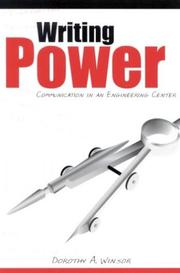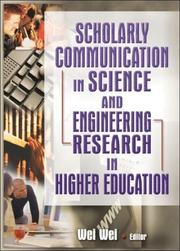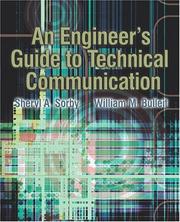| Listing 1 - 10 of 10 |
Sort by
|
Book
Year: 2018 Publisher: [Place of publication not identified] : Firenze University Press,
Abstract | Keywords | Export | Availability | Bookmark
 Loading...
Loading...Choose an application
- Reference Manager
- EndNote
- RefWorks (Direct export to RefWorks)
The Publication is following the yearly Editions of EVA FLORENCE. The State of Art is presented regarding the Application of Technologies (in particular of digital type) to Cultural Heritage. The more recent results of the Researches in the considered Area are presented. Information Technologies of interest for Culture Heritage are presented: multimedia systems, data-bases, data protection, access to digital content, Virtual Galleries. Particular reference is reserved to digital images (Electronic Imaging & the Visual Arts), regarding Cultural Institutions (Museums, Libraries, Palace - Monuments, Archaeological Sites). The International Conference includes the following Sessions: Strategic Issues; New Sciences and Culture Developments and Applications; New Technical Developments & Applications; Museums - Virtual Galleries and Related Initiatives; Art and Humanities Ecosystem & Applications; Access to the Culture Information. Two Workshops regard: Innovation and Enterprise; the Cloud Systems connected to the Culture (eCulture Cloud) in the Smart Cities context. The more recent results of the Researches at national and international are reported in the Area of Technologies and Culture Heritage, also with experimental demonstrations of developed Activities.
Book
ISBN: 1283895889 1606502530 9781606502532 9781283895880 1606502514 9781606502518 Year: 2012 Publisher: [New York, N.Y.] (222 East 46th Street, New York, NY 10017) Momentum Press
Abstract | Keywords | Export | Availability | Bookmark
 Loading...
Loading...Choose an application
- Reference Manager
- EndNote
- RefWorks (Direct export to RefWorks)
Everyone knows about the rising phenomena of social media, but what does that have to do with you, the engineer? What about engineers looking for employment? And can you really push your consultancy business, publication, and more to establish your own personal brand? Do engineering companies really need social media? Social networks are both a blessing and a curse to the engineer and scientist. The blessings are apparent: the abundance of free applications and their increasing mobility and transportability. The curse is that creating interesting and compelling content on these user-driven systems is best served by right-brain skills. But most engineers and scientists are left-brain oriented, and have generally shunned the right-brain skills like graphic design and creative writing as being indulgent and time wasting. This new book shows you how to develop better "right brain" skills and apply them to social media like Facebook, Twitter, LinkedIn and others, where so much professional communication, marketing, promoting and even collaborative technical work is taking place today.

ISBN: 0791486702 9780791486702 9780791457580 0791457583 0791457575 0791457583 9780791457573 Year: 2003 Publisher: Albany : State University of New York Press,
Abstract | Keywords | Export | Availability | Bookmark
 Loading...
Loading...Choose an application
- Reference Manager
- EndNote
- RefWorks (Direct export to RefWorks)
Winner of the 2004 Distinguished Publication on Business Communication presented by the Association of Business CommunicationWriting Power examines the way that texts, knowledge, and hierarchy generate and support one another within a for-profit corporation. By encouraging us to see texts and writing as powerful operators in the corporate world, this book presents a case study focused on how one engineering organization uses texts to create and maintain its knowledge and power structure. Based on over five years of observations, the book describes the co-generation of power/knowledge/text from several points of view, including that of managers, engineers, interns, and blue-collar workers. These groups of people use texts to build knowledge within their own areas and establish control over their work when it is passed along to the other groups. Employing Bourdieu's notion that people possess different kinds of "capital" that can be converted to one another under the right circumstances, the book demonstrates that text is one of the major ways that this conversion of capital takes place, and is thus one of the major ways that power and knowledge are generated and accumulated.
Communication in engineering. --- Technical writing. --- Engineering --- Science --- Scientific writing --- Technology --- Authorship --- Communication of technical information

ISBN: 0203049969 1283968584 1136414568 9781136414565 0789021773 9780789021779 0789021781 9780789021786 9781136414633 1136414630 9780203049969 9781136414701 Year: 2004 Publisher: Binghamton, NY Haworth Information Press
Abstract | Keywords | Export | Availability | Bookmark
 Loading...
Loading...Choose an application
- Reference Manager
- EndNote
- RefWorks (Direct export to RefWorks)
Stay on top with the latest developments in scientific and technical journal publications! In Scholarly Communication in Science and Engineering Research in Higher Education, experts in the academic community propose cost-effective alternatives to commercial publications in the face of increased journal prices and reduced budgets. This book discusses recent technological innovations that can maintain the needs of researchers who need to stay on the cutting edge of science and technology as well as scholars who must be published and peer-reviewed in order to achieve tenure and promotio
Communication in science. --- Communication in engineering. --- Engineering --- Communication in research --- Science communication --- Science information --- Scientific communications --- Science
Book
ISBN: 1612494382 1612494390 9781612494395 9781612494388 9781557537232 1557537232 Year: 2016 Publisher: West Lafayette, Indiana : Purdue University Press,
Abstract | Keywords | Export | Availability | Bookmark
 Loading...
Loading...Choose an application
- Reference Manager
- EndNote
- RefWorks (Direct export to RefWorks)
Communication in design --- Communication in engineering design --- Industrial design --- Engineering design --- Design --- Design, Engineering --- Engineering --- Strains and stresses --- Evaluation
Book
ISBN: 9780128026724 0128026723 0128025794 9780128025796 Year: 2018 Publisher: London, United Kingdom : Academic Press, an imprint of Elsevier,
Abstract | Keywords | Export | Availability | Bookmark
 Loading...
Loading...Choose an application
- Reference Manager
- EndNote
- RefWorks (Direct export to RefWorks)
Communicating as Women in STEM discusses various communication styles, also demonstrating how principles can be applied during interpersonal interactions in day-to-day environments. It provides women and other underrepresented groups, faculty and administrators with the tools they need to break barriers raised by different communication styles within the STEM fields. Sections cover tactics on how to become more aware of communication patterns and how to cope with, and improve, communication. This practical resource for women in the STEM fields is also ideal for mentors, educators, advisers and organizations interested in encouraging women to choose and remain in these fields. -- Provided by publisher.
Women --- Communication in science. --- Communication in engineering. --- Communication. --- Communication --- Engineering --- Communication in research --- Science communication --- Science information --- Scientific communications --- Science

ISBN: 0130482420 Year: 2006 Publisher: S.l. S.l. Pearson Prentice Hall
Abstract | Keywords | Export | Availability | Bookmark
 Loading...
Loading...Choose an application
- Reference Manager
- EndNote
- RefWorks (Direct export to RefWorks)
Science --- Study methods --- Personnel management --- Mass communications --- technische documentatie --- communicatie --- rapporteren --- schrijftechniek --- ingenieurswetenschappen --- Communication in engineering --- Technical writing --- Engineering --- Scientific writing --- Technology --- Authorship --- Communication of technical information
Book
ISBN: 9780817394240 0817394249 9780817321420 Year: 2023 Publisher: Tuscaloosa, Ala The University of Alabama Press
Abstract | Keywords | Export | Availability | Bookmark
 Loading...
Loading...Choose an application
- Reference Manager
- EndNote
- RefWorks (Direct export to RefWorks)
"This work exposes the deeply worrying state of discourse over geoengineering-the intentional manipulation of the earth's climate as means to halt or reverse global warming. These climate-altering projects, which range from cloud-whitening to carbon dioxide removal and from stratospheric aerosol injection to enhanced weathering, are all technological solutions to more complex geosocial problems. Geoengineering represents one of the most alarming forms of deliberative discourse in the twenty-first century. Yet geoengineering could easily generate as much harm as the environmental traumas it seeks to cure. Complicating these deliberations is the scarcity of public discussion. Most deliberations transpire within policy groups, behind the closed doors of climate-oriented startups, between subject-matter experts at scientific conferences, or in the disciplinary jargon of research journals. Further, much of this conversation occurs primarily in the West. Ehren Helmut Pflugfelder makes clear how the deliberative rhetorical strategies coming from geoengineering advocates have been largely deceptive, hegemonic, deterministic, and exploitative. In this volume, he investigates how geoengineering proponents marshal geologic actors into their arguments-and how current discourse could lead to a greater exploitation of the earth in the future. Pflugfelder's goal is to understand the structure, content, purpose, and effect of these discourses, raise the alarm about their deliberative directions, and help us rethink our approach to the climate. In highlighting both the inherent problems of the discourses and the ways geologic rhetoric can be made productive, he attempts to give "the geologic" a place at the table to better understand the roles that all earth systems continue to play in our lives, now and for years to come"--
Book
ISBN: 9783319076744 3319076736 9783319076737 3319076744 Year: 2015 Publisher: Cham : Springer International Publishing : Imprint: Springer,
Abstract | Keywords | Export | Availability | Bookmark
 Loading...
Loading...Choose an application
- Reference Manager
- EndNote
- RefWorks (Direct export to RefWorks)
This book covers diverse aspects of advanced computer and communication engineering, focusing specifically on industrial and manufacturing theory and applications of electronics, communications, computing, and information technology. Experts in research, industry, and academia present the latest developments in technology, describe applications involving cutting-edge communication and computer systems, and explore likely future directions. In addition, access is offered to numerous new algorithms that assist in solving computer and communication engineering problems. The book is based on presentations delivered at ICOCOE 2014, the 1st International Conference on Communication and Computer Engineering. It will appeal to a wide range of professionals in the field, including telecommunication engineers, computer engineers and scientists, researchers, academics, and students.
Engineering. --- Communications Engineering, Networks. --- Data Mining and Knowledge Discovery. --- Artificial Intelligence (incl. Robotics). --- Data mining. --- Artificial intelligence. --- Telecommunication. --- Ingénierie --- Exploration de données (Informatique) --- Intelligence artificielle --- Télécommunications --- Electrical & Computer Engineering --- Engineering & Applied Sciences --- Electrical Engineering --- Computer engineering --- Computer science --- Engineering --- Electrical engineering --- Telecommunication --- Communication in engineering --- Wireless communication systems --- Information technology --- Data processing --- Artificial Intelligence. --- AI (Artificial intelligence) --- Artificial thinking --- Electronic brains --- Intellectronics --- Intelligence, Artificial --- Intelligent machines --- Machine intelligence --- Thinking, Artificial --- Bionics --- Cognitive science --- Digital computer simulation --- Electronic data processing --- Logic machines --- Machine theory --- Self-organizing systems --- Simulation methods --- Fifth generation computers --- Neural computers --- Electric communication --- Mass communication --- Telecom --- Telecommunication industry --- Telecommunications --- Communication --- Information theory --- Telecommuting --- Algorithmic knowledge discovery --- Factual data analysis --- KDD (Information retrieval) --- Knowledge discovery in data --- Knowledge discovery in databases --- Mining, Data --- Database searching --- Electrical engineering. --- Electric engineering
Book
ISBN: 1283945193 3642333893 3642333885 9783642333880 Year: 2013 Publisher: Berlin Springer Berlin
Abstract | Keywords | Export | Availability | Bookmark
 Loading...
Loading...Choose an application
- Reference Manager
- EndNote
- RefWorks (Direct export to RefWorks)
The book is the follow-up to its predecessor “Automation, Communication and Cybernetics in Science and Engineering 2009/2010” and includes a representative selection of all scientific publications published between 07/2011 and 06/2012 in various books, journals and conference proceedings by the researchers of the following institute cluster: IMA - Institute of Information Management in Mechanical Engineering ZLW - Center for Learning and Knowledge Management IfU - Associated Institute for Management Cybernetics Faculty of Mechanical Engineering, RWTH Aachen University Innovative fields of application, such as cognitive systems, autonomous truck convoys, telemedicine, ontology engineering, knowledge and information management, learning models and technologies, organizational development and management cybernetics are presented.
Mathematics. --- Management. --- Industrial management. --- Artificial intelligence. --- Computer mathematics. --- Science education. --- Robotics. --- Automation. --- Communication. --- Computational Science and Engineering. --- Artificial Intelligence (incl. Robotics). --- Robotics and Automation. --- Science Education. --- Communication Studies. --- Innovation/Technology Management. --- Automatic factories --- Automatic production --- Computer control --- Engineering cybernetics --- Factories --- Industrial engineering --- Mechanization --- Assembly-line methods --- Automatic control --- Automatic machinery --- CAD/CAM systems --- Robotics --- Communication, Primitive --- Mass communication --- Sociology --- Automation --- Machine theory --- Science education --- Scientific education --- Computer mathematics --- Discrete mathematics --- Electronic data processing --- AI (Artificial intelligence) --- Artificial thinking --- Electronic brains --- Intellectronics --- Intelligence, Artificial --- Intelligent machines --- Machine intelligence --- Thinking, Artificial --- Bionics --- Cognitive science --- Digital computer simulation --- Logic machines --- Self-organizing systems --- Simulation methods --- Fifth generation computers --- Neural computers --- Business administration --- Business enterprises --- Business management --- Corporate management --- Corporations --- Industrial administration --- Management, Industrial --- Rationalization of industry --- Scientific management --- Management --- Business --- Industrial organization --- Administration --- Industrial relations --- Organization --- Math --- Science --- Mathematics --- Communication in engineering. --- Communication in science. --- Cybernetics. --- Mechanical brains --- Control theory --- Electronics --- System theory --- Communication in research --- Science communication --- Science information --- Scientific communications --- Engineering --- Computer science. --- Artificial Intelligence. --- Study and teaching. --- Informatics
| Listing 1 - 10 of 10 |
Sort by
|

 Search
Search Feedback
Feedback About UniCat
About UniCat  Help
Help News
News